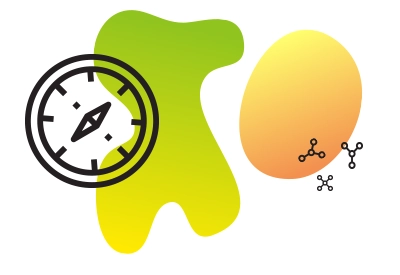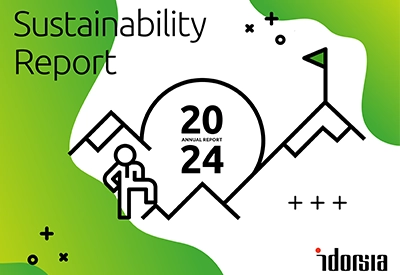| Content |
GRI number |
Disclosure title |
Comments or omissions |
Chapter |
Page |
| |
|
|
|
|
|
General disclosures
|
2-1 |
Organizational details |
|
Governance Report 2024
Appendix 1:
About this report
|
4-5
69
|
| 2-2 |
Entities included in the organization’s sustainability reporting |
|
Appendix 1:
About this report |
69 |
| 2-3 |
Reporting period, frequency and contact point |
Financial reporting and sustainability reporting both run from January 1 to December 31 (annual) |
Appendix 1:
About this report |
69 |
| 2-4 |
Restatements of information |
|
Appendix 1:
About this report |
69 |
Activities and workers
|
2-6 |
Activities, value chain, and other business relationships |
Idorsia belongs to the biotechnology industry according to the Global Industry Classification Standard (GICS®) (Biotechnology: 352010) |
More drive –
For a better future
Appendix 1:
About this report
|
8
69
|
| 2-7 |
Employees |
|
People and society |
28
|
| 2-8 |
Workers who are not employees |
Omission: information unavailable/incomplete. Idorsia relies on highly skilled external experts across the value chain. Due to the project-based nature of these engagements, the number of external workers fluctuates. |
|
|
Governance
|
2-9 |
Governance structure and composition |
|
Governance Report 2024 |
14-26
|
| 2-10 |
Nomination and selection of the highest governance body |
|
Governance Report 2024
Company by-laws
|
18
|
| 2-11 |
Chair of the highest governance body |
|
Governance Report 2024 |
14
|
| 2-12 |
Role of the highest governance body in overseeing the management of impacts |
|
More drive –
For a better future |
10-11 |
| 2-13 |
Delegation of responsibility for managing impacts |
|
More drive –
For a better future |
10-11
|
| 2-14 |
Role of the highest governance body in sustainability reporting |
|
More drive –
For a better future |
4, 11
|
| 2-15 |
Conflicts of interest |
|
Company by-laws |
11-12 |
| 2-16 |
Communication of critical concerns |
|
More drive –
For a better future
Whistleblowing policy
|
11, 57
5
|
| 2-17 |
Collective knowledge of the highest governance body |
|
Compliance and business ethics |
56-61 |
| 2-18 |
Evaluation of the performance of the highest governance body |
|
Compensation Report 2024 |
12-13, 18-19 |
| 2-19 |
Remuneration policies |
|
Compensation Report 2024 |
10-15 |
| 2-20 |
Process to determine remuneration |
|
Compensation Report 2024 |
8 |
| 2-21 |
Annual total compensation ratio |
Omission: Confidentiality constraints. Idorsia does not publicly disclose this data. |
|
|
Strategy
|
2-22 |
Statement on sustainable development strategy |
|
More drive –
For a better future |
4-5
|
| 2-23 |
Policy commitments |
|
Compliance and business ethics
People and society
Environment
|
55,
65-67
27
43-44
|
| 2-24 |
Embedding policy commitments |
|
Compliance and business ethics |
56-57 |
| 2-25 |
Processes to remediate negative impacts |
|
More drive –
For a better future |
10-17 |
| 2-26 |
Mechanisms for seeking advice and raising concerns |
|
Compliance and business ethics
Whistleblowing policy
|
55-57
1-6
|
| 2-27 |
Compliance with laws and regulations |
|
Compliance and business ethics
Environment
|
55, 64
53
|
| 2-28 |
Membership associations |
Idorsia does not hold any significant role in an association or advocacy organization. |
|
|
Stakeholder engagement
|
2-29 |
Approach to stakeholder engagement |
|
More drive –
For a better future |
14 |
| 2-30 |
Collective bargaining agreements |
|
Compliance and business ethics |
67 |
Material topics
|
3-1 |
Process to determine material topics |
|
More drive –
For a better future |
14
|
| 3-2 |
List of material topics |
|
More drive –
For a better future |
15-16 |
| 3-3 |
Management of material topics |
|
Sustainability Report/management approaches |
|
Economic performance
|
201-1 |
Direct economic value generated and distributed |
|
Financial Report 2024 |
5-16 |
| Compliance and business ethics |
205-1 |
Operations assessed for risks related to corruption |
|
Compliance and business ethics |
55-56 |
| 205-2 |
Communication and training about anti-corruption policies and procedures |
|
Compliance and business ethics |
57-58 |
| Energy |
302-1 |
Energy consumption within the organization |
|
Environment |
46 |
| Water |
303-1 |
Interactions with water as a shared resource |
|
Environment |
52 |
| 303-3 |
Water withdrawal |
|
Environment |
53 |
Emissions
|
305-1 |
Direct (Scope 1) GHG emissions |
|
Environment |
47 |
| 305-2 |
Energy indirect (Scope 2) GHG emissions |
|
Environment |
47 |
| 305-3 |
Other indirect (Scope 3) GHG emissions |
|
Environment |
47-48 |
| Waste |
306-1 |
Waste generation and significant waste-related impacts |
|
Environment |
49-50 |
| 306-2 |
Management of significant waste-related impacts |
|
Environment |
43,
49-50 |
| 306-3 |
Waste generated |
|
Environment |
50 |
| 306-4 |
Waste diverted from disposal |
|
Environment |
51 |
| 306-5 |
Waste directed to disposal |
|
Environment |
51 |
Supplier environmental assessment
|
308-1 |
New suppliers that were screened using environmental criteria |
|
Compliance and business ethics |
66 |
| 308-2 |
Negative environmental impacts in the supply chain and actions taken |
|
Compliance and business ethics |
65-66 |
Employment
|
401-1 |
New employee hires and employee turnover |
|
People and society |
29-30 |
| 401-2 |
Benefits provided to full-time employees that are not provided to temporary or part-time employees |
|
People and society |
31-33 |
Occupational health and safety
|
403-1 |
Occupational health and safety management system |
|
People and society |
34 |
| 403-2 |
Hazard identification, risk assessment, and incident investigation |
|
People and society |
34 |
| 403-5 |
Worker training on occupational health and safety |
|
People and society |
36 |
| 403-6 |
Promotion of worker health |
|
People and society |
31-33 |
| 403-8 |
Workers covered by an occupational health and safety management system |
|
People and society |
34 |
| 403-9 |
Work-related injuries |
|
People and society |
35 |
| 403-10 |
Work-related ill health |
|
People and society |
35 |
Training and education
|
404-2 |
Programs for upgrading employee skills and transition assistance programs |
|
People and society |
31 |
Diversity and inclusion
|
405-1 |
Diversity of governance bodies and employees |
|
People and society |
38-39 |
Supplier social assessment
|
414-1 |
New suppliers that were screened using social criteria (including animal welfare) |
|
Compliance and business ethics
Appendix 3: Child labor and conflict minerals due diligence
|
66
73
|
| 414-2 |
Negative social impacts in the supply chain and actions taken |
|
Compliance and business ethics
Appendix 3: Child labor and conflict minerals due diligence
|
65-66
73
|
Customer health and safety
|
416-1 |
Assessment of the health and safety impacts of product and service categories |
The pharmaceutical industry is subject to strict regulatory requirements with which we comply. |
Compliance and business ethics |
62-64 |
Marketing and labelling
|
417-1 |
Requirements for product and service information and labeling |
The pharmaceutical industry is subject to strict regulatory requirements. This information is obligatory for us to have in order to operate. |
Compliance and business ethics |
64 |
SASB
|
HC-BP-260a.1. |
Description of methods and technologies used to maintain traceability of products throughout the supply chain and prevent counterfeiting |
|
Compliance and business ethics |
64 |
| HC-BP-260a.2. |
Discussion of process for alerting customers and business partners of potential or known risks associated with counterfeit products |
|
Compliance and business ethics |
64 |
| HC-BP-000.B |
Number of drugs (1) in portfolio and (2) in research and development (3) marketed |
|
Portfolio |
|

